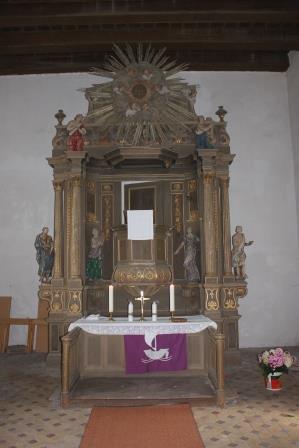The Church of Papendorf in a Baroque Perspective
A short history of its construction
At the beginning of the 14th century, the rectangular shaped foundation walls, made of boulders, were used as a base for the later church of Papendorf. The half-timbered tower was attached in 1745. During the 19th century the tower was renovated and completely covered with yellow boulders; the rectangular choir was also added on the southern foundation-wall. The church bell was founded by Stettin craftsman Ernst Voss in 1889.
Papendorf during the 17th and 18th century
During the Thirty Years’ War from 1618-1648 imperial troops of the Habsburg emperor Ferdinand II occupied Pomerania. In this decade, Pomerania suffered from violence and destruction. Also, the town Pasewalk, close to Papendorf, was burned down in 1630. After the negotiations to the peace of Westphalia 18 years later, Sweden received the western part of Pomerania and also Papendorf got under Swedish reign. During these times, many conflicts and wars weakened the north-eastern part of the Holy Roman Empire. However, the peace of Stockholm in 1720 ended war in Pomerania and the population recovered.
A general view on the pulpit altar

In the baroque perspective, the pulpit altar is a typical interior in Lutheran churches.Especially between the 17th and 19th century pulpit altars were very popular and so, a pulpit was attached above the altar table.
During the reformation pulpits were increasingly established in churches, because of the growing importance of the sermon. Thus, the symbiosis of the pulpit and the altar shows the new importance of the sermon in the liturgy. In addition to this, the scarce space in the churches is used effectively and the audience sits closer to the pastor.
The pulpit altar of Papendorf
Unfortunately, the builder of the altar is unknown until present. Furthermore, the pulpit altar, which was established in 1715, nowadays needs a renovation.
The polygonal pulpit with its ceiling is framed by four Corinthian pedestals. The whole altar is ornamented with floral and shell-shaped objects. The centered eye of god with coronal clouds, cherubs and a gloriole of sunbeams is attached above the pulpit ceiling.
Furthermore, there are six figures attached to the pulpit altar. Some of them were probably allegories, which could be differentiated by the colours of their garments. The majority of these figures have a female form, while one of them is obviously a male. This sculpture could be Moses or Saint Peter, however it is not possible recognize who the figure really is, because the face and the attributes are missing.
